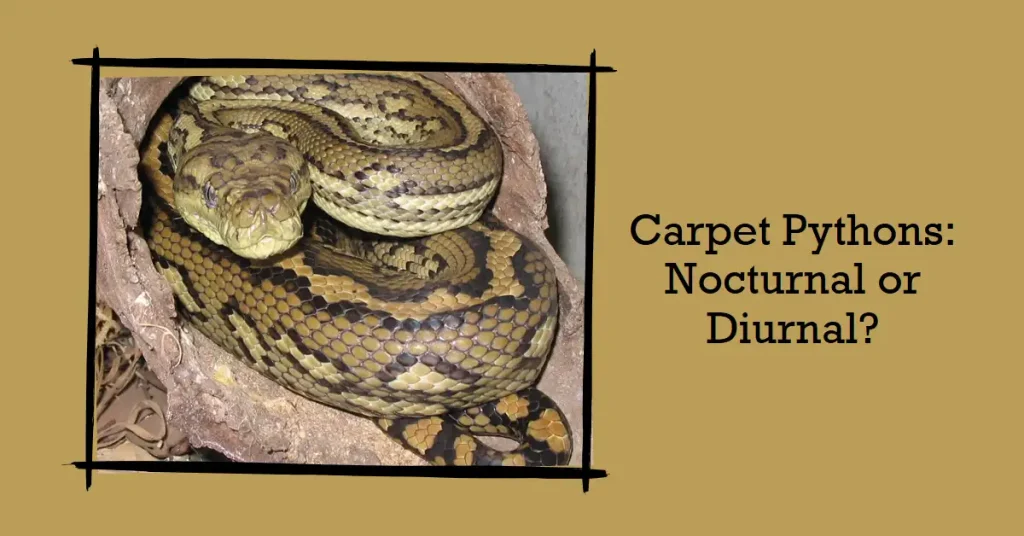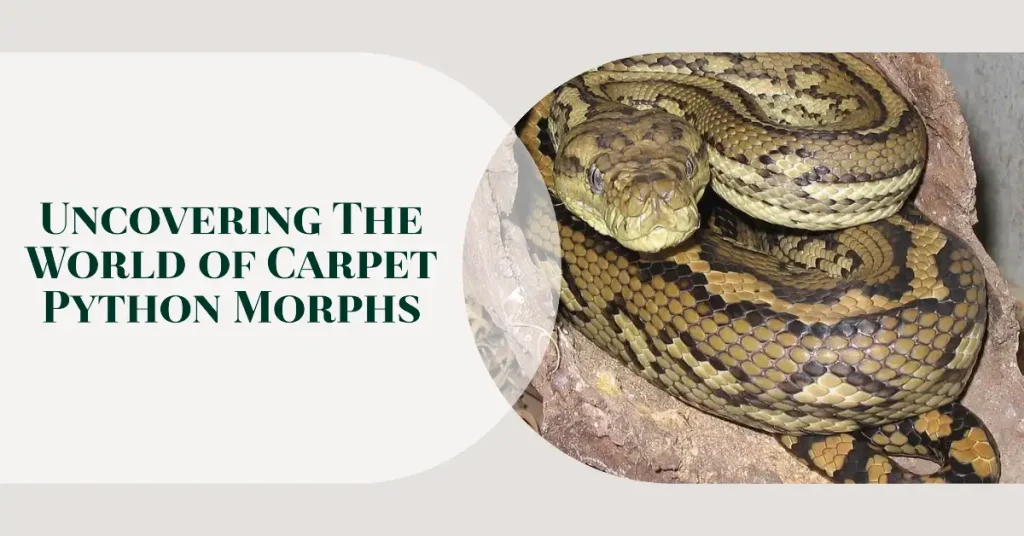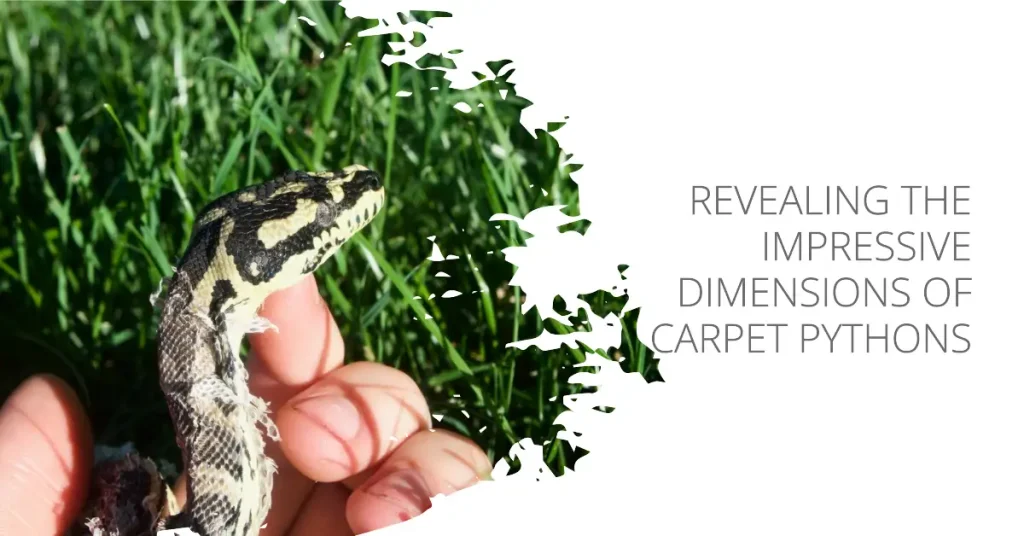In the wild, carpet pythons are primarily nocturnal. This behavior allows them to hunt for prey under the cover of darkness, taking advantage of cooler temperatures and reduced visibility to stealthily approach their prey. During the day, they often rest in sheltered spots, such as tree branches or hollows, to conserve energy and avoid predators.
In the following paragraphs, we will discuss this topic in more detail…
Carpet pythons, including the jungle carpet pythons, are known to be nocturnal creatures. They exhibit a preference for night-time activities, while opting to rest and relax during the daytime in tree branches. These magnificent snakes thrive in arboreal habitats, specifically dense sub-tropical rainforests, and are often found near rivers or streams. They are nonvenomous and survive on a diet consisting of lizards, small mammals, birds, and frogs in their natural habitat. In captivity, carpet pythons are commonly fed rats, mice, and baby rabbits to meet their nutritional needs. These remarkable reptiles can live up to 30 years when provided with proper care.
Key Takeaways:
- Carpet pythons, such as jungle carpet pythons, are nocturnal creatures that are more active at night.
- They prefer arboreal habitats, such as dense sub-tropical rainforests, and are often found near rivers or streams.
- In the wild, carpet pythons mainly feed on lizards, small mammals, birds, and frogs.
- In captivity, they are typically fed rats, mice, and baby rabbits.
- Proper care, including providing suitable housing with appropriate heating and lighting conditions, is essential for their well-being.
- Common health issues in carpet pythons include mites, abnormal shedding, and respiratory infections.
Behavior of Carpet Pythons
Carpet pythons exhibit distinct behavior patterns, with their nocturnal habits being a prominent feature. These snakes are primarily active during the night, utilizing their well-developed heat-sensing pits to navigate and hunt in the darkness. While they may occasionally bask in the sun, especially during cooler seasons, they prefer to spend their daytime hours coiled up and resting in tree branches or other elevated perches.
As nocturnal hunters, carpet pythons rely on stealth and patience to capture their prey. They possess excellent camouflage abilities, blending seamlessly with their surroundings as they patiently wait for unsuspecting prey to come within striking range. Once their prey is detected, carpet pythons strike with lightning-fast speed, using their sharp teeth to immobilize their victims before constricting them with their powerful bodies.
Interestingly, carpet pythons also display some crepuscular behavior, meaning they may be active during dawn or dusk. During these transitional periods, they may engage in activities such as basking, thermoregulating, or engaging in courtship behaviors. However, their primary hunting and foraging activities still occur under the cover of darkness.
Hunting behavior comparison table:
| Nocturnal Behavior | Crepuscular Behavior | |
|---|---|---|
| Hunting Time | Primarily at night | During dawn and dusk |
| Prey Detection | Relies on heat-sensing pits to locate prey in the dark | Utilizes both heat-sensing pits and visual cues |
| Hunting Style | Ambush hunter, striking with speed and precision | Opportunistic hunter, taking advantage of lower light conditions |
Environmental Preferences
Carpet pythons prefer to relax and rest during the day while they are most active at night. These nocturnal creatures exhibit fascinating sleeping patterns and engaging activity at nighttime. Being more active during the darker hours allows them to exploit their excellent camouflage and stealth to their advantage, aiding in their hunting endeavors.
In their natural habitat, carpet pythons are commonly found in arboreal environments like dense sub-tropical rainforests. These lush and forested regions offer the perfect setting for the pythons to thrive. They tend to seek refuge in the branches of trees, providing them with safety and security from potential threats. Additionally, they often choose to reside near bodies of water such as rivers or streams, as these areas provide a readily available source of hydration and potential hunting grounds.
When kept in captivity, it is essential to replicate their natural environment as closely as possible. This includes providing them with spacious enclosures that allow for climbing and ample resting spaces. The enclosure should also have appropriate heating and lighting conditions. Maintaining a basking spot with a temperature range of 30-34°C mimics their natural habitat and ensures their thermoregulation needs are met.
| Key Factors for Carpet Python Enclosure Setup | |
|---|---|
| Factor | Requirement |
| Enclosure Size | Large with sufficient height for climbing |
| Heating | Basking spot at 30-34°C |
| Lighting | Full-spectrum lighting to mimic natural sunlight |
| Substrate | Natural materials such as bark or cypress mulch |
| Decorations | Branches, foliage, and hiding spots |
Natural Habitat
Carpet pythons are commonly found in arboreal habitats, particularly in dense sub-tropical rainforests. These lush rainforests provide the perfect environment for carpet pythons, offering ample cover and a diverse range of prey. The dense vegetation and tall trees allow them to thrive in their natural habitat, where they can climb and hide among the branches.
“Carpet pythons are highly adapted to life in the trees, and their arboreal nature is reflected in their physical characteristics. Their slender bodies, strong muscles, and prehensile tails enable them to move gracefully through the canopy, utilizing branches as both a means of transportation and camouflage.”
While dense sub-tropical rainforests serve as their primary habitat, carpet pythons can also be found in other arboreal environments such as woodlands, swamps, and even urban areas with a significant tree presence. They are known to seek out areas near bodies of water, such as rivers or streams, as they provide a constant source of hydration and attract a variety of prey.
The combination of an arboreal lifestyle and the abundance of prey in these habitats makes dense sub-tropical rainforests a perfect home for carpet pythons. The tall trees offer them a safe vantage point from which to survey their surroundings and ambush unsuspecting prey. It is within this unique habitat that carpet pythons can fully display their impressive hunting abilities.
| Key Features of Carpet Python’s Natural Habitat: |
|---|
| Arboreal environment, such as dense sub-tropical rainforests |
| Tall trees providing cover and vantage points |
| Presence of bodies of water for hydration and prey attraction |
| Diverse range of prey available |
Diet and Feeding Habits
Carpet pythons are carnivorous snakes that feed on a variety of prey, including lizards, small mammals, birds, and frogs. They are skilled hunters and use their strong bodies and sharp teeth to capture and consume their prey. In the wild, carpet pythons will locate their prey using their excellent sense of smell and thermal vision. Once they have located a suitable target, they will strike quickly, wrapping their body around the prey and constricting it until it suffocates.
In captivity, carpet pythons are usually fed a diet of rats, mice, and baby rabbits. These prey items need to be appropriately sized for the snake, ensuring that they are neither too large nor too small. Feeding live prey is generally not recommended as it can pose a risk to the snake and may result in injury. Instead, it is advised to feed them thawed and warmed-up frozen rodents. This not only eliminates the risk of the prey fighting back but also ensures that the snake remains safe during feeding.
Table: Feeding Guide for Carpet Pythons in Captivity
| Prey Size | Frequency of Feeding |
|---|---|
| Newborn Mice | Weekly |
| Weaner Rats | Fortnightly |
| Small Rats | Monthly |
It is important to note that the exact feeding schedule and prey size may vary depending on the age, size, and individual needs of each carpet python. Consulting with a reptile veterinarian or experienced snake keeper can provide more specific guidance on feeding habits for individual snakes.
Captivity and Care
When kept in captivity, carpet pythons require specific heating and lighting conditions for their well-being. These conditions aim to replicate their natural habitat and provide them with the necessary warmth and light for proper digestion, shedding, and overall health. Adequate heating and lighting are essential aspects of caring for these beautiful snakes.
To provide the necessary heat, it is recommended to incorporate various heating elements in the enclosure. This can include the use of ceramic heat emitters, heat mats, or radiant heat panels. These heating sources should be strategically placed to create a thermal gradient within the enclosure, allowing the snake to move between warmer and cooler areas as desired. A basking spot should be maintained at a temperature of 30-34°C (86-93°F), which is essential for carpet pythons to digest their food properly.
In addition to heating, proper lighting is crucial for carpet pythons. UVB lighting, specifically in the form of fluorescent tubes or compact bulbs, is necessary to provide these snakes with the required UVB radiation. UVB aids in the synthesis of vitamin D3, which is vital for calcium metabolism and overall bone health. It is important to note that UVB bulbs should be replaced regularly as their effectiveness diminishes over time.
Feeding Guidelines
Carpet pythons are carnivorous and should be fed a diet consisting of appropriately sized prey items. In captivity, they are typically fed rats, mice, and baby rabbits, which should be sourced from reputable suppliers. It is crucial to provide them with pre-killed prey that has been thawed and warmed up to mimic the temperature of live prey. This helps ensure the safety of the snake and prevents injuries during feeding.
Feeding frequency varies depending on the age and size of the snake. Juvenile carpet pythons may require feeding every 5-7 days, while adults may only need to be fed every 1-2 weeks. Monitoring the snake’s body condition and adjusting the feeding schedule accordingly is crucial to prevent underfeeding or obesity.
When feeding, it is essential to create a peaceful environment for the snake. Disturbances during feeding can cause stress and potentially lead to regurgitation. To avoid this, it is recommended to feed carpet pythons in a separate feeding container or isolate them in a designated feeding area within their enclosure.
Enclosure Hygiene and Care
Maintaining cleanliness and hygiene in the snake’s enclosure is paramount to their well-being. Regular spot cleaning of feces and uneaten prey is necessary to prevent the buildup of bacteria and odors. Additionally, a regular deep clean of the enclosure using an appropriate reptile-safe disinfectant is essential to minimize the risk of infection and disease transmission.
It is important to provide adequate hiding spots and climbing opportunities in the enclosure. Carpet pythons are semi-arboreal, so vertical climbing branches, sturdy branches, and foliage should be offered to cater to their natural behavior. These additions not only enhance the snake’s well-being but also provide environmental enrichment and stimulation.
| Heating and Lighting Conditions: | Feeding Guidelines: | Enclosure Hygiene and Care: |
|---|---|---|
| Specific heating elements for thermal gradient | Feed appropriately sized pre-killed prey | Regular spot cleaning and deep cleaning of enclosure |
| Basking spot at 30-34°C (86-93°F) | Monitor body condition and adjust feeding schedule | Provide hiding spots and climbing opportunities |
| Use UVB lighting for optimal calcium metabolism | Feed in a peaceful and designated area | Ensure adequate environmental enrichment |
Lifespan and Housing
With proper care, carpet pythons can live up to 30 years in captivity. These snakes require large enclosures with sufficient height for climbing and space to explore. Providing a suitable habitat is crucial to ensuring their optimal health and well-being.
When setting up the enclosure for a carpet python, it is important to recreate their natural habitat as closely as possible. This includes providing branches or perches for climbing and basking, as well as hiding spots for security. A substrate that retains humidity, such as cypress mulch or coconut fiber, can be used to mimic their natural forest floor.
Temperature and lighting conditions are also essential for carpet python housing. These snakes are ectothermic and rely on external sources for heat regulation. It is recommended to provide a temperature gradient within the enclosure, with a basking spot maintained at 30-34°C (86-93°F) and a cooler side ranging from 24-27°C (75-81°F). A combination of heat bulbs, ceramic heat emitters, and under-tank heating pads can be used to achieve and maintain the appropriate temperatures. Full-spectrum UVB lighting should also be provided to support their overall health and natural behaviors.
| Enclosure Requirements | Recommended Specifications |
|---|---|
| Size | At least 4 feet long, 2 feet wide, and 2 feet tall |
| Material | Glass, PVC, or melamine enclosures are commonly used |
| Security | Securely latched doors and escape-proof design |
| Substrate | Cypress mulch, coconut fiber, or other humidity-retaining substrate |
| Branches and Perches | Provide sturdy branches or perches for climbing and basking |
| Hiding Spots | Include multiple hiding spots for security |
| Temperature and Lighting | Provide a temperature gradient and full-spectrum UVB lighting |
Regular cleaning and maintenance of the enclosure is essential to prevent the build-up of waste and bacteria. Spot cleaning should be done as needed, and a thorough cleaning with a reptile-safe disinfectant should be conducted regularly. Water should be provided in a sturdy bowl large enough for the snake to soak in if desired.
When housing multiple carpet pythons together, it is crucial to consider their size and compatibility. Adequate space and hiding spots should be provided to prevent aggression and stress. It is recommended to consult with a reptile expert or veterinarian knowledgeable in snake care for specific guidance on housing multiple carpet pythons.
Feeding in Captivity
In captivity, carpet pythons are typically fed rats, mice, and baby rabbits, which should be thawed and warmed up before feeding. These snakes have a healthy appetite and are known to be voracious eaters. They are capable of consuming prey larger than their head, thanks to their unique jaw structure that allows for stretching and unhinging.
When feeding carpet pythons, it is essential to provide appropriately sized prey items to ensure the snake’s safety. The size of the prey should be proportional to the snake’s girth, allowing for proper digestion. As they grow, their prey size should also increase accordingly. It is recommended to feed them once every 1-2 weeks, depending on their size and age.
Table 1: Example of carpet python feeding schedule based on size and age:
| Size | Age | Prey Size | Feeding Frequency |
|---|---|---|---|
| Small | Juvenile | Pinky mice, small rats, or fuzzy rats | Once every 7-10 days |
| Medium | Sub-adult | Small to medium-sized rats | Once every 10-14 days |
| Large | Adult | Medium to large-sized rats or small rabbits | Once every 14-21 days |
It is important to ensure that the prey items are of high quality and free from any parasites or toxins. Frozen rodents can be easily obtained from reptile specialty stores and should be thawed and warmed up before feeding to mimic the natural body temperature of live prey. This can be achieved by placing the frozen prey in warm water or using a heat lamp for a short period.
Captive carpet pythons may demonstrate different feeding behavior compared to their wild counterparts. Some individuals may be finicky eaters or go off food temporarily during breeding season or during periods of stress. If a snake refuses several consecutive meals or displays any concerning health symptoms, it is advisable to consult a veterinarian experienced in reptile care for guidance and assistance.
Common Health Issues
Like any reptile, carpet pythons are prone to certain health issues, including mites, abnormal shedding, and respiratory infections. It is important for python keepers to be aware of these potential problems and take necessary precautions to maintain their snake’s well-being.
Mites
Mites are a common pest in snakes and can cause significant discomfort and stress for the affected python. These tiny parasites feed on the snake’s blood and can lead to anemia, skin irritation, and overall weakened health. To prevent mite infestations, it is crucial to regularly inspect the snake for any signs of mites, such as tiny black or red specks on the scales or in the enclosure. If mites are detected, there are various treatments available, including topical insecticides and thorough cleaning of the enclosure and accessories.
Abnormal Shedding
Carpet pythons, like other snakes, shed their skin periodically as they grow. However, sometimes the shedding process can become problematic, resulting in incomplete sheds or retained pieces of old skin. This can lead to serious health issues and discomfort for the snake. To minimize the risk of abnormal shedding, ensure that the enclosure provides proper humidity levels for the python, allowing for a smooth shedding process. Additionally, providing a damp hide box or soaking the snake in warm water can help facilitate shedding if any difficulties arise.
Respiratory Infections
Respiratory infections can occur in carpet pythons if they are exposed to cold or damp conditions. These infections can lead to symptoms such as wheezing, open-mouth breathing, and nasal discharge. Adequate heating and proper ventilation in the enclosure are crucial in preventing respiratory infections. If a respiratory infection is suspected, it is important to seek veterinary care promptly, as these infections can worsen rapidly if left untreated.
| Health Issue | Symptoms | Treatment |
|---|---|---|
| Mites | Tiny black or red specks on scales, skin irritation | Topical insecticides, thorough cleaning |
| Abnormal Shedding | Incomplete sheds, retained pieces of old skin | Proper humidity, damp hide box, soaking |
| Respiratory Infections | Wheezing, open-mouth breathing, nasal discharge | Veterinary care, heating, proper ventilation |
Are Carpet Pythons Nocturnal – Conclusion
Carpet pythons, particularly jungle carpet pythons, are indeed nocturnal snakes, with their behavior and habitat preferences aligning with nighttime activity. These pythons are more active at night, utilizing the cover of darkness to hunt for their prey. During the day, they prefer to rest and relax in the tree branches of their arboreal habitats, such as dense sub-tropical rainforests. They are often found near bodies of water, like rivers or streams, where they can find both food and shelter.
Carpet pythons have a diverse diet, including lizards, small mammals, birds, and frogs. In captivity, they are typically fed rats, mice, and baby rabbits. With proper care, carpet pythons can live up to 30 years, so it is important to provide them with appropriate housing and environmental conditions. Large enclosures with sufficient height for climbing are recommended, along with heating and lighting conditions that include a basking spot maintained at 30-34°C.
Featured Image: Amos T Fairchild, CC BY-SA 3.0, via Wikimedia Commons


